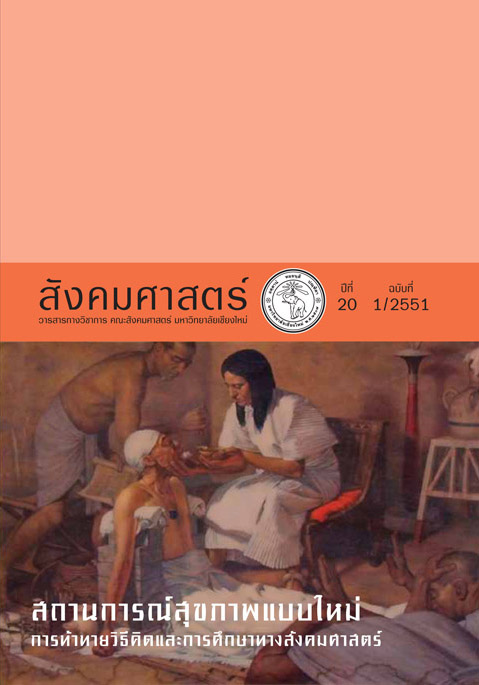สภาพการทำงานและพฤติกรรมการดูแลสุขภาพของสตรีที่ทำงานไม้แกะสลัก
Main Article Content
Abstract
Woodcarving is a well-known industry within the informal work sector in the city of Chiang Mai. Most woodcarving workers are sub-contractors, and this contractual status has the potential to impact upon the health of themselves and of their family, if there are inappropriate controls put in place to ensure good working conditions. The research study combined both qualitative and quantitative methodologies, in order to study background data about the working conditions and health problems among wood carving workers in Khunkhong sub-district, Hang Dong, in Chiang Mai Province. Data gathering methods included the interview by questionnaire of 100 female woodcarving workers, relevant document reviews, unstructured discussions with key informants, and also observation of the work process and environment. Furthermore, in-depth interviews and focus groups were conducted with 69 people, covering wood carvers, entrepreneurs, community leaders, health officials and village health volunteers. In addition, a forum was arranged to present and verify the collected data and also to receive additional information from a further 81 people who were also wood carving workers, entrepreneurs, health officials and public health volunteers.
The study found that most female workers do the decoration and the assembly work. Also, many workers interviewed know that they face risk factors and may experience health problems from their work, particularly from sitting in continually inappropriate positions, from contact with and inhalation of dust and chemicals, as well as further risks from operating the machines. Illnesses most frequently reported included aches and pains, especially backache. These were followed by asthma and other respiratory diseases, gastric ulcers, eye and eyesight problems, skin problems, and accidents. If the health problems are minor, workers take care of them by themselves. However, for serious illnesses beyond their ability to treat, they go to a health station.
Article Details
All written articles published on Journal of Social Sciences is its author’s opinion which is not belonged to Faculty of Social Sciences, Chiang Mai University or is not in a responsibility of the journal’s editorial committee’s members.
References
เจียรนัย โพธิ์ไทรย์. 2544. หลักการส่งเสริมการคลอดด้วยตนเอง. เชียงใหม่:
แพรการพิมพ์.
ฉลาดชาย รมิตานนท์. 2547. “กระบวนทัศน์เกี่ยวกับสุขภาพและภูมิปัญญาพื้นบ้านเกี่ยวกับสุขภาพ”, ใน เอกสารประกอบการสัมมนาเรื่อง ทฤษฎีสังคมกับการปฏิรูปสังคมและสุขภาพ, ณ ห้องประชุมจุมภฏ-พันธุ์ทิพย์ อาคารประชาธิปก-รำไพพรรณี จุฬาลงกรณ์มหาวิทยาลัย, 4-5 พฤศจิกายน 2547.
ธีระศักดิ์ มูลสาร. 2542. “การผ่าตัดคลอดทางหน้าท้องกับสัญลักษณ์แห่งความ
เป็นแม่ที่ปลอดภัยในกระแสวัฒนธรรมบริโภคนิยม”. วารสารสังคมศาสตร์การแพทย์ 10 (2): 20-33.
นภาพร ชโยวรรณ, ชเนตตี มิลินทรางกูร, บุศริน บางแก้ว, ปรียา รุ่งโสภากุล,มาลินี วงษ์สิทธิ์, รักชนก คชานุบาล, วิพรรณ ประจวบเหมาะและ ศิริวรรณ ศิริบุญ. 2546. ภาวะเศรษฐกิจกับการเปลี่ยนแปลงทางประชากรและครอบครัวในประเทศไทย. กรุงเทพ: วิทยาลัยประชากรศาสตร์ จุฬาลงกรณ์มหาวิทยาลัย.
พัชรา วิชัยดิษฐ์. 2540. ปัจจัยทางสังคมวัฒนธรรมที่สัมพันธ์กับการตัดสินใจเลือกผ่าตัดคลอดทางหน้าท้องของมารดา.วิทยานิพนธ์สังคมศาสตร์มหาบัณฑิต สาขาสังคมศาสตร์การแพทย์และสาธารณสุข บัณฑิตวิทยาลัยมหาวิทยาลัยมหิดล.
พนา พวงมะลิ. 2541. การผ่าตัดคลอดทางหน้าท้อง: ค่านิยมของหญิงตั้งครรภ์.
วิทยานิพนธ์สังคมศาสตร์มหาบัณฑิต สาขาสังคมศาสตร์การแพทย์และสาธารณสุข บัณฑิตวิทยาลัย มหาวิทยาลัยมหิดล.
ภิเศก ลุมภิกานนท์. 2533. “ผ่าท้องคลอดดีจริงหรือ?”. วารสารศูนย์แพทยศาสตร์ 16 (3): 120–128.
ฟิลิป เกสต์. 2539. “การลดลงของภาวะเจริญพันธุ์ในประเทศไทย: ตัวกำหนดและผลกระทบ”, ใน กุศล สุนทรธาดา (บก.), จุดเปลี่ยนนโยบายประชากรประเทศไทย. กรุงเทพ : สำนักงานกองทุนสนับสนุนการวิจัย.
ยศ ตีระวัฒนานนท์, ฐิติมา สุนทรสัจ, สัญญา ศรีรัตนา, ปรัศนี ทิพโสถิตย์,วัชรา ริ้วไพบูลย์, วิโรจน์ ตั้งเจริญเสถียร. 2546ก.“ผลดี ผลเสีย การฝากครรภ์พิเศษในโรงพยาบาลของรัฐ”. วารสารวิชาการสาธารณสุข 12 (4):496 – 508.
ยศ ตีระวัฒนานนท์, , วิโรจน์ ตั้งเจริญเสถียร, สัญญา ศรีรัตนา, ปรัศนี ทิพ-โสถิตย์. 2546ข. “แบบแผนการคลอดบุตรของหญิงไทยในรอบ 12 ปี(2533 –2544)”. วารสารวิชาการสาธารณสุข 12 (1): 1–18.
วิชิต เปานิล. 2546. พุทธกระบวนทัศน์เพื่อสุขภาพและการเยียวยาในสังคมไทย.
กรุงเทพ: สถาบันวิจัยระบบสาธารณสุข.
วิโรจน์ ตั้งเจริญเสถียร, งามจิตต์ จันทรสาธิต, ชลลดา สิทธิทูรย์. 2541.แบบแผนการคลอดบุตรในโรงพยาบาล ปี 2533 – 2539. กรุงเทพ:สถาบันวิจัยระบบสาธารณสุข.
อนุวัฒน์ ศุภชูติกุล. 2539. “การบริหารจัดการเทคโนโลยีทางการแพทย์และสาธารณสุข”, ใน เอกสารประกอบการนำเสนอในที่ประชุมวิชาการประจำปีของสถาบันวิจัยระบบสาธารณสุข เรื่องการปฏิรูปเพื่อสุขภาพ:ยุทธศาสตร์ใหม่สู่การพัฒนาระบบ, 1-2 กุมภาพันธ์ 2539. กรุงเทพ:สถาบันวิจัยระบบสาธารณสุข.
Freund, P.S. and Mcquire, M.B. 1995. Health Illness and the Social Body.
New Jersey: Prentice-Hall.
Johanson, R.N. and Mary, M.A. 2002. Has the Medicalisation of Childbirth
Gone Too far? British Medical Journal 324: 892 –895.
Leonie, P. 2004. “Caesarean Section on Request for Non-medical
Indications”. Current Obstetrics & Gynecology 14: 220 -223.
Lock, M. and Scheper-Hughes, N. 1990. “A Critical Interpretive Approach in
Medical Anthropology: Rituals and Routines of Discipline and Dissent.
In M. Thomas, & C. F. Sargent (Eds.)”, Medical anthropology contemporary theory and method. New York: Praeger.
Piralrat Pothong. 2002. “Factor Affecting Elective Caesarean Section Among
Nulliparous Women”. Thesis M.S (Public health) Faculty of graduate
studies Mahidol University.
Perkins, B. B. 2004. The Medical Delivery Business: Health Reform,
Childbirth, and the Economic Order. New Brunswick NJ: Rutgers University Press.
Ritzer, G. 2000. “Frontiers of McDonaldization: Birth, Death, and DeathDefying Acts”. In George Ritzer, The McDonaldization of Society, (pp.
146-165). California: Pine Forge Press.
Shearer, E. L. 1993. “Cesarean Section: Medical Benefts and Costs”, Social
Science & Medicine 37(10): 1223-1231.
Wyatt, David K. 1966. “The Buddhist Monkhood as an Avenue of Social
Mobility, in Traditional Thai Society” Sinlapakon, Vol. X No. 1.


